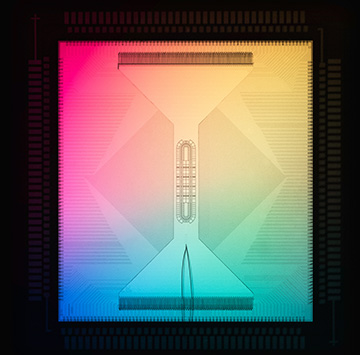
[Image: Courtesy of Quantinuum]
Quantinuum, a maker of quantum processors built on arrays of laser-controlled trapped ions, has officially launched its second-generation system, the Model H2, which the company characterizes as “the highest-performing quantum computer ever built.” And the company unveiled that new system with a flourish: It announced, at the same time, that the H2 had allowed researchers to create and control a heretofore elusive, long-sought quasiparticle excitation that some believe offers a promising route to universal fault-tolerant quantum computing.
The quasiparticles in question—obscurely named “non-Abelian anyons”—open up the prospect of so-called topological quantum computing, in which complex entangled states are “braided” into structures that are uniquely resistant to error. The demonstration and control of these states on the Quantinuum H2 system doesn’t amount fault-tolerant, topological quantum computing in itself. But the company believes that its processor offers a unique platform for driving toward that goal.
“This was only possible because of our second-generation quantum computer, which—at its level right now, as it’s operating—is the highest-performing quantum computer in the world,” Tony Uttley, Quantinuum’s president and chief operating officer, told OPN. “We are at a stage now in quantum computing where you can start to go do things that are just impossible in any other way.”
Chasing “quantum volume”
Quantinuum was formed at the end of 2021 through the merger of two entities: US-based Honeywell Quantum Solutions, focused on development of trapped-ion quantum-computing hardware; and UK-based Cambridge Quantum, involved with quantum middleware and software applications. The company now employs more than 480 persons worldwide, including more than 350 scientists and engineers.
In benchmarking its quantum computers, Quantinuum focuses on the metric of “quantum volume.” This metric—as originally defined by IBM Corp.—takes into account not only the number of qubits but also such measures of qubit quality as gate fidelity, to measure the complexity of problems a specific quantum machine can solve (at least in principle).
Quantinuum’s H1 processor, the 20 quantum bits (qubits) of which consist of laser-controlled ions stored in a linear ion trap, sports a quantum volume of 32,768. That’s by far the largest quantum volume heretofore reported; the next-highest competitor, IBM’s 27-qubit superconducting Falcon r10 “Prague” system, has a current reported quantum volume of 512.

The Quantinuum H2 chip’s ion trap features a “racetrack’ geometry that enables all-to-all qubit connectivity. [Image: Courtesy of Quantinuum]
The H2 system, officially released by Quantinuum today, now doubles the H1’s performance, with a quantum volume of 65,536. The system is built around a trapped-ion chip with a “racetrack” geometry that enables “all to all” connectivity and pairwise entanglement between all qubits. The geometry also, according to Quantinuum’s director of commercial hardware, Russell Stutz, allowed the company to boost the systems qubit count from 20 in the H1 to 32 in the H2—with the possibility, he adds, of easily adding more.
Stutz attributes the high performance of the company’s computers both to the inherent scalability of trapped-ion quantum systems relative to other qubit flavors, and to the specific architecture choices made by Quantinuum. “It made us do a lot of up-front work to go with this architecture,” Stutz says. “But now it’s paid off.”
Wrangling non-Abelian anyons
The company showcased the capabilities of the H2 system with its effort, several years in the making, to create and manipulate the exotic quasiparticle excitations called non-Abelian anyons. These quasiparticles were first identified 20 years ago as a possible route to fault-tolerant quantum computing. That’s because the complex combination of these states, referred to as braiding, creates a topological order in which the quasiparticle states are stored nonlocally—which, in turn, protects them from errors caused by local perturbations.
A team led by Henrik Dreyer in the Quantinuum operation in Munich, Germany, and also including physicists from the company’s Colorado, USA, headquarters and from Caltech and Harvard University, USA, focused on teasing out these quasiparticle excitations on the company’s H2 processor. To do so, the team used the all-to-all connectivity enabled by the racetrack processor to wrangle an array of 27 trapped ions into a specific entangled state. They then walked that state through an increasingly complex set of manipulations, including the braiding of non-Abelian anyons that has been proposed as the basis for potential fault-tolerant topological quantum computing.
“Checkmarks” to fault-tolerant quantum computing

Quantinuum COO Tony Uttley. [Image: Courtesy of Quantinuum]
In a paper reporting the accomplishment, posted on the arXiv, the team dubs it “the first unambiguous realization of non-Abelian [topological order].” However, Uttley notes that there is still far to go between the creation and control of these topological qubits—which he calls “the first of three big checkmarks”—and deploying them in a fault-tolerant quantum computer.
The second of Uttley’s big checkmarks is using the topological qubits in a universal gate set, which he describes as “not easy, but straightforward.” And the third will be reaching a stability level that allows that universal gate set to be deployed in a new kind of topological computing system. “This is all work that is still to be done,” Uttley says, “but you can’t even start to do those unless you have that first, gigantic one out of the way. And this is now the only place on the planet to be able to go and do that.”
Uttley adds that the company’s trapped-ion computers are also an excellent platform for advancing fault-tolerant computing through more conventional approaches to quantum error correction. “We have two gigantic opportunities,” he says. “And they both sit on the same trapped-ion hardware.”
The road ahead
The H2 system, which Uttley says has been running since November, is available to customers via cloud-based access through Quantinuum, and will become accessible through Microsoft’s Azure cloud service in June. “We have actually turned it on for our customers already,” Uttley notes; JP Morgan Chase, for example, recently validated results on a quantum algorithm for portfolio optimization using the H2 system.
Quantinuum’s processor roadmap. [Image: quantinuum.com] [Enlarge image]
Looking ahead, Quantinuum is already at work on the next generation of trapped-ion chip, under a disciplined product roadmap that moves from the linear geometry of the H1 and still quasi-1D geometry of the H2 to increasingly integrated, 2D grid geometries and tiled traps. The company envisions rolling out these increasingly complex processors—in which laser-controlled ions can perform intricate feats such as turning corners—over the course of the 2020s.
In parallel with that, the company is pursuing work to miniaturize the optics and to move light delivery ever closer to the trap. It is also building on the expertise of the electronics industry to miniaturize and scale the control electronics in parallel.
The power of hardware and software
According to Uttley, the company’s recent announcement and its progress thus far have hinged in some sense on Quantinuum’s status as a combined hardware–software firm.
“What we really like about this story is that the first ingredient to do this was to have a fully integrated quantum computing company,” he says. “That’s why we came together as Quantinuum. It takes this absolutely deep hardware knowledge how everything works; you have to sit another layer of operating system on top of that; and then you have to sit in an application layer on top of that … If you work all [of that] together, that’s where you get these just incredible results.”

